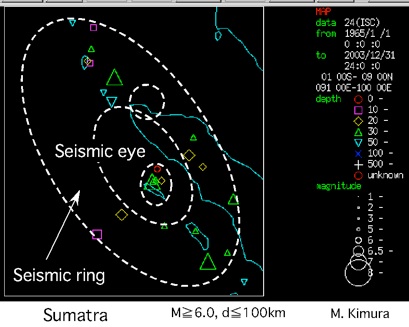My Blog

About 2004 Sumatra Earthquake (8.7)
Predicting a big earthquake is done based on the seismic source data. The seismic source data published in ISC were used, and seismicity maps were made by using Seis View of the Earthquake Research Institute of University of Tokyo.
10.2.3

Now, I would like to predict a great earthquake occurred in Sumatra (M8.7 and Ms 9.3) in 2004 by the data.
1) In order to predict of occurrence of the 2004 Sumatra Earthquake, seismic data were chosen from 1965 to 2003. First of them, epicenters less than M8.7 and larger than M8.0 were plotted in order to look for a seismic gap. At first, I chosed events larger than M8 is plotted in the area to look for an seismic eye proposed by Kimura (2008). However, no events were appeared in the area. Then, I chose events larger than M7.5. One event exits. I think this may be a shock for a seismic eye as shown in Fig.1-(1).

2) Then, I chose events larger than M6.0 events. Epicenters concentrates the “Seismic eye?” area in Fig.1-(2). And that Other events surrounding the “Seismic eye?”area. Therefore, the “Seismic eye?”wais regarded as “Seismic eye”, and surrounded part was done as a Seismic ring or donut in Fig. 1-(2).
3) Next, events larger than M4 were chosen. Seismicity concentration is seen at the eye (Fig2-(1)). By this, it is supposed that a main shock larger than 8 would occur near the eye.

4) The chronological order of the frequency of earthquakes (M≧4) in the eye area is shown in Fig. 2-(2). Seismicity increased from 1976 step by step. Three steps are observed as E1, E2 and E3 in Fig. 2-(2). The 1976 year should be defined as a starting point of E1 based on
preveous studies in the other region (Kimura, 2006).
5) Then, 30 years are added to this year (1976). The limit of error is ±4 years in previous studies. By this, it is estimated easily as the main shock would occur in 2006±4 year. Really, the main shock occurred in 2004. It should be fallen in the predicted year.
Referrence
Kimura, M. How to look for the earthquake eye. Daisanbunmei-sha, 238pp., Tokyo, 2006 (in Japanese).
